

Local councilor succumbs to pandemic: the Spanish Flu and the death of Captain Douglas Weir
Jeff Packard
Douglas Weir was Jeff's great-uncle.
In 1912 Douglas Weir, then 29 years of age, and his father, Robert Stanley Weir, jointly bought a farm in the Cedarville area from the estate of the late George Hall. Douglas had studied microbiology at the University of Toronto and then had done post-graduate studies at Cornell and then McGill. 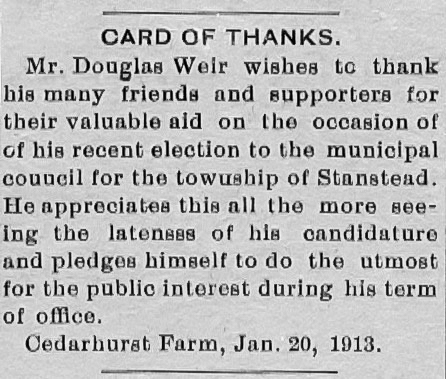 He was then hired as a lecturer in biology at Macdonald College in St Anne de Bellevue where he taught for 5 years. In 1912 he left his post in order to apply the latest advances in pest control and scientific farming to his own farm in the Eastern Townships. Almost simultaneously his friend and colleague, Herman Dasen, also left a teaching position at Macdonald and bought the neighbouring farm in Cedarville.
He was then hired as a lecturer in biology at Macdonald College in St Anne de Bellevue where he taught for 5 years. In 1912 he left his post in order to apply the latest advances in pest control and scientific farming to his own farm in the Eastern Townships. Almost simultaneously his friend and colleague, Herman Dasen, also left a teaching position at Macdonald and bought the neighbouring farm in Cedarville.
Douglas Weir had spent summers in Cedarville since 1895, so he was very familiar with the region. Nonetheless, being thrust into the life of a fulltime farmer must have been quite an adjustment. He did gradually become more involved in the community and in 1912 ran, and won a seat as a councillor for the Township of Stanstead (Ogden did not come into existence until 1932).
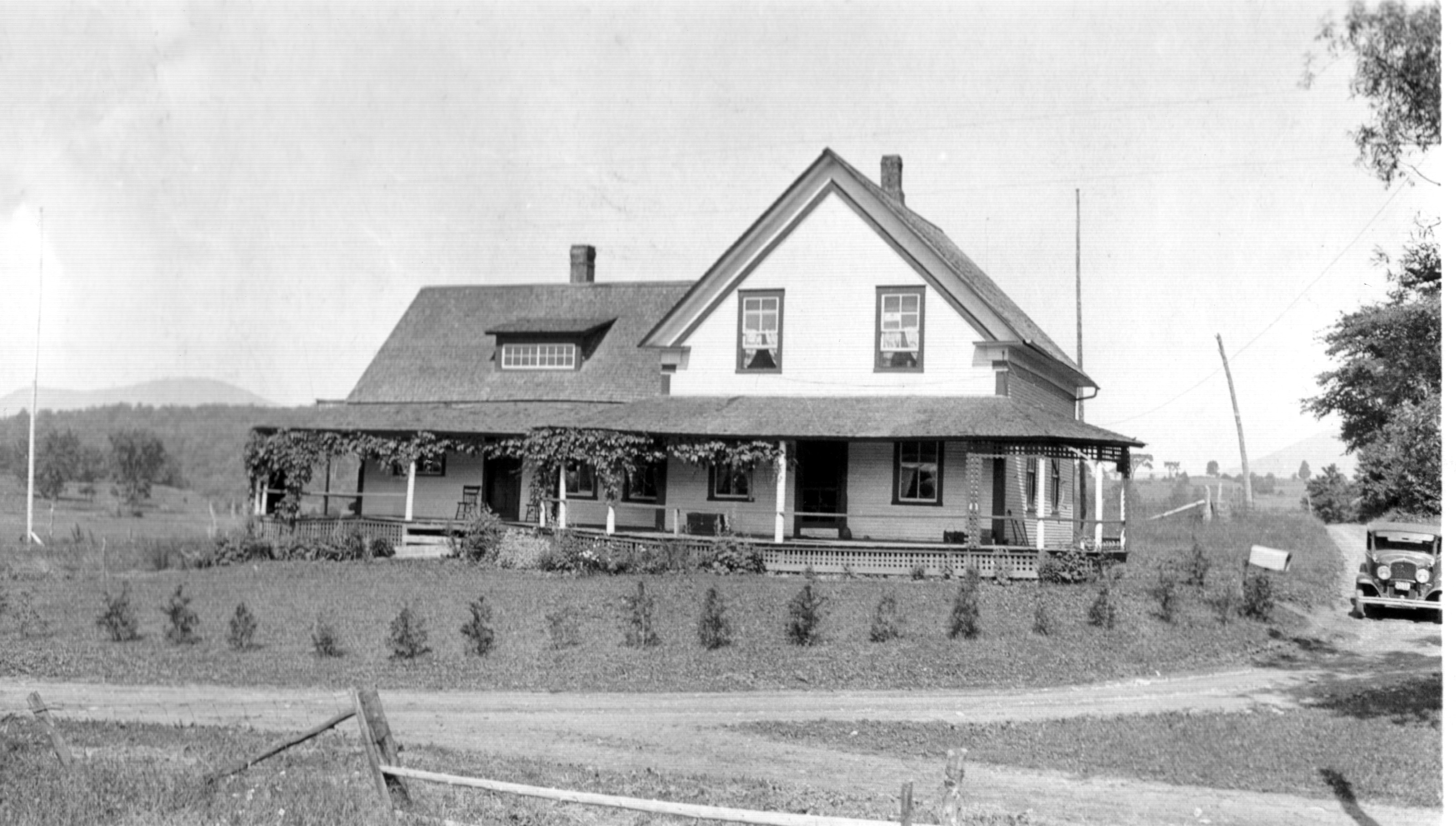
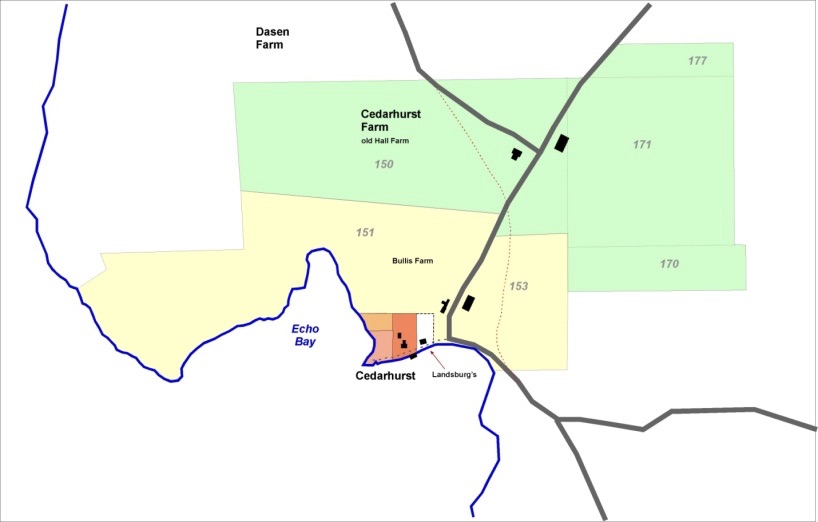
The following is the story of his death, from the Spanish Flu, a mere 13 hours after the guns had fallen silent on the Western Front in 1918.
Douglas Weir arrived in England on July 5 1916, part of yet another contingent of Canadian soldiers, the 4th Divisional Train of the Canadian Army Service Corps (CASC). He disembarked from the HMS Olympic (sister ship to the Titanic) and the following day he was taken on strength with the Transport Division (CASC TD), and was soon moved to No.3 depot in Whitley, some 60 km due west of London. Subsequently on August 27th Douglas was transferred to CASC TD in Shorncliffe. His role then changed quite markedly for on September 9th he was transferred out of the CASC and into the Canadian Forestry Corps (CFC), a quite separate arm of the CEF. Whether this was the result of a need, an opportunity, or a request remains unknown, but Douglas would spend the rest of his days with the CFC. In civilian life both Douglas and his father Robert had had an interest in sylviculture, and both had joined the Canadian Forestry Association in 1903. It is entirely reasonable to believe that this interest of the younger Weir, played a role in his placement. What may have been more relevant was Douglas’s expertise in logistics and supplies.
strength with the Transport Division (CASC TD), and was soon moved to No.3 depot in Whitley, some 60 km due west of London. Subsequently on August 27th Douglas was transferred to CASC TD in Shorncliffe. His role then changed quite markedly for on September 9th he was transferred out of the CASC and into the Canadian Forestry Corps (CFC), a quite separate arm of the CEF. Whether this was the result of a need, an opportunity, or a request remains unknown, but Douglas would spend the rest of his days with the CFC. In civilian life both Douglas and his father Robert had had an interest in sylviculture, and both had joined the Canadian Forestry Association in 1903. It is entirely reasonable to believe that this interest of the younger Weir, played a role in his placement. What may have been more relevant was Douglas’s expertise in logistics and supplies.
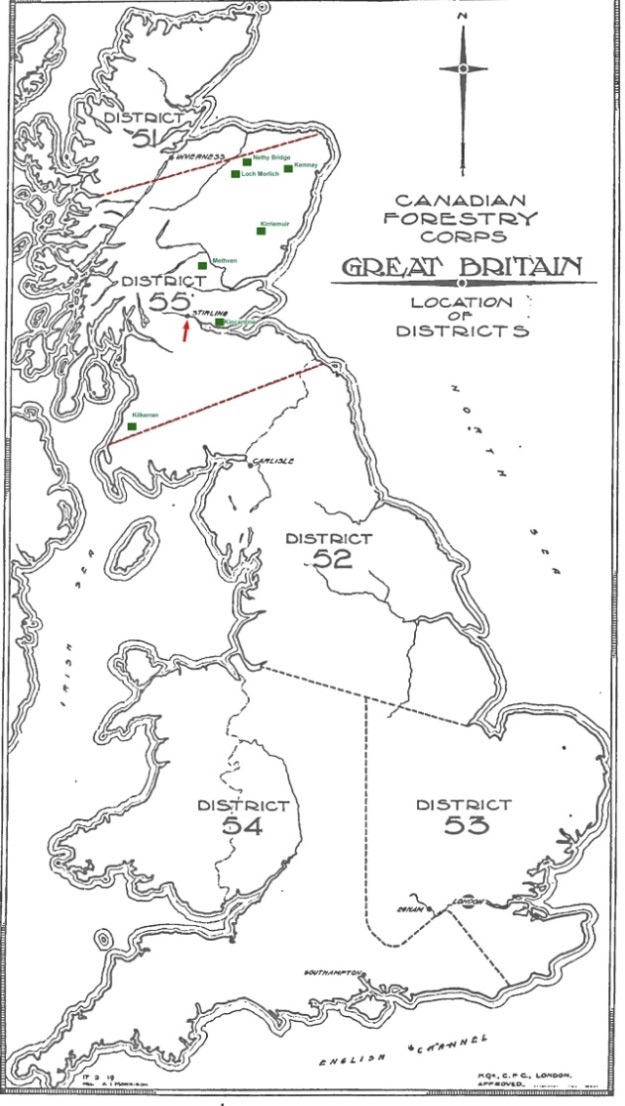
He had enlisted as early as October 1914, but was not called up until March 1915 when he joined the Canadian Army Service Corps, and was placed in charge of supplies in Military District No 5 (Quebec City including Valcartier), and in addition was an instructor in logistics for junior officers with the CASC School of Instruction. In March 1916 Douglas volunteered to go overseas.
The Canadian Forestry Corps was first raised in early 1916, at the request of the Imperial War Cabinet, in order to procure in the remaining forests of Great Britain and France, the vast amount of timber required to sustain the war effort1. By harvesting the wood in Europe, this freed up ships sailing from Canada and running the German submarine blockade, to carry even more urgent and less bulky supplies such as food and munitions. The first units arrived in England in late April of 1916.
Douglas Weir never set foot in France, and spent most of the war at CFC headquarters in London, acting as Chief Forester and Officer in charge of the Forestry and Food Production Branch.
Clearly his sense of duty and a desire to remain relatively close to Wilmot and their 18 month old son, were important factors in his decision.
The 55th District comprised roughly the southern half of Scotland, and was one of 5 districts in Great Britain. A 6th District (the 56th) had no geographical constraints but was assigned to clear and build aerodromes in Britain as a counter to the Zeppelin threat. The 55th District included a total of seven companies (~1400 men) of the 224th Battalion. Typically district headquarters would be in charge of a Colonel, the Second-in-Command having Major's rank, and the Adjutant that of Captain; there were also a Quartermaster (Hon. Captain), a Transport Officer (Captain), and a Messing Officer (Lieutenant), with the necessary assistants. The Staff of the Stirling District Headquarters, which would have included Douglas, only consisted of three officers, plus 29 other ranks of the Canadian Forestry Corps, and five of the Canadian Army Service Corps. The Headquarters itself had been established in November of 1917, and was housed in a large private residence which had been taken over by the War Office. Operations in the general area that was to become District 55 had started as early as June of 1916, but most of the lumbering in the district was done in the 1917-1918 period (see map, above).
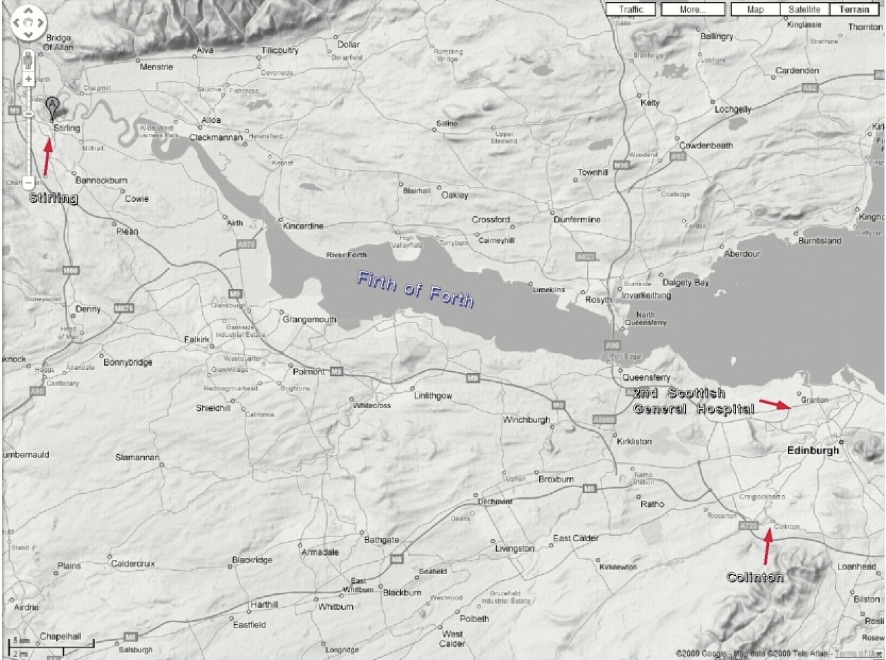
The officers and men of Headquarters were billeted in the town of Stirling, and according to the account given by Bird and Davies (1919), would have had “the pleasantest memories of the hospitality and courtesy of the inhabitants.” Indeed so pleasant was the hospitality in the entire District, that within a single company (approximately 200 men), 27 Scottish brides were found by the men over the course of one year. Douglas was clearly not the exception, only he had found his Scottish bride (Wilmot) in London!
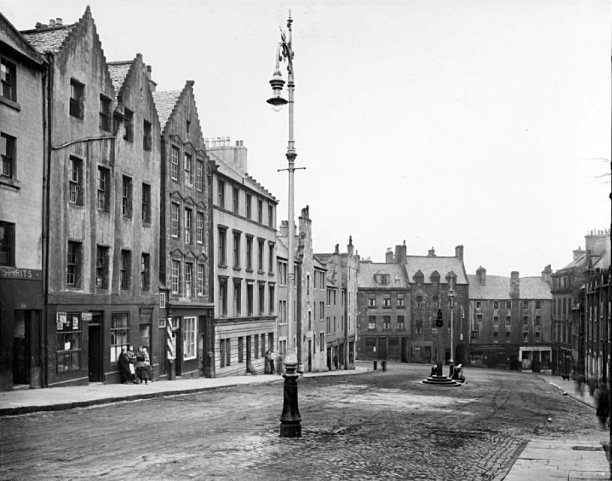
The active lumbering operations in District 55 were very widespread, from Nethy Bridge in the north, to Kilkerran in the southwest, and given the travel allowances claimed by Douglas each month, his position as Transport Officer required considerable travel.
It is not known whether Wilmot and Ian stayed in London or relocated to Scotland, but I suspect they either remained in London, or more likely, moved to Colinton Village (now a suburb of Edinburgh) where Wilmot had family. Stirling to Colinton would not have been a daily commute. Douglas was provided a monthly subsidy while in Stirling, of $30, and this was likely to pay his billet.
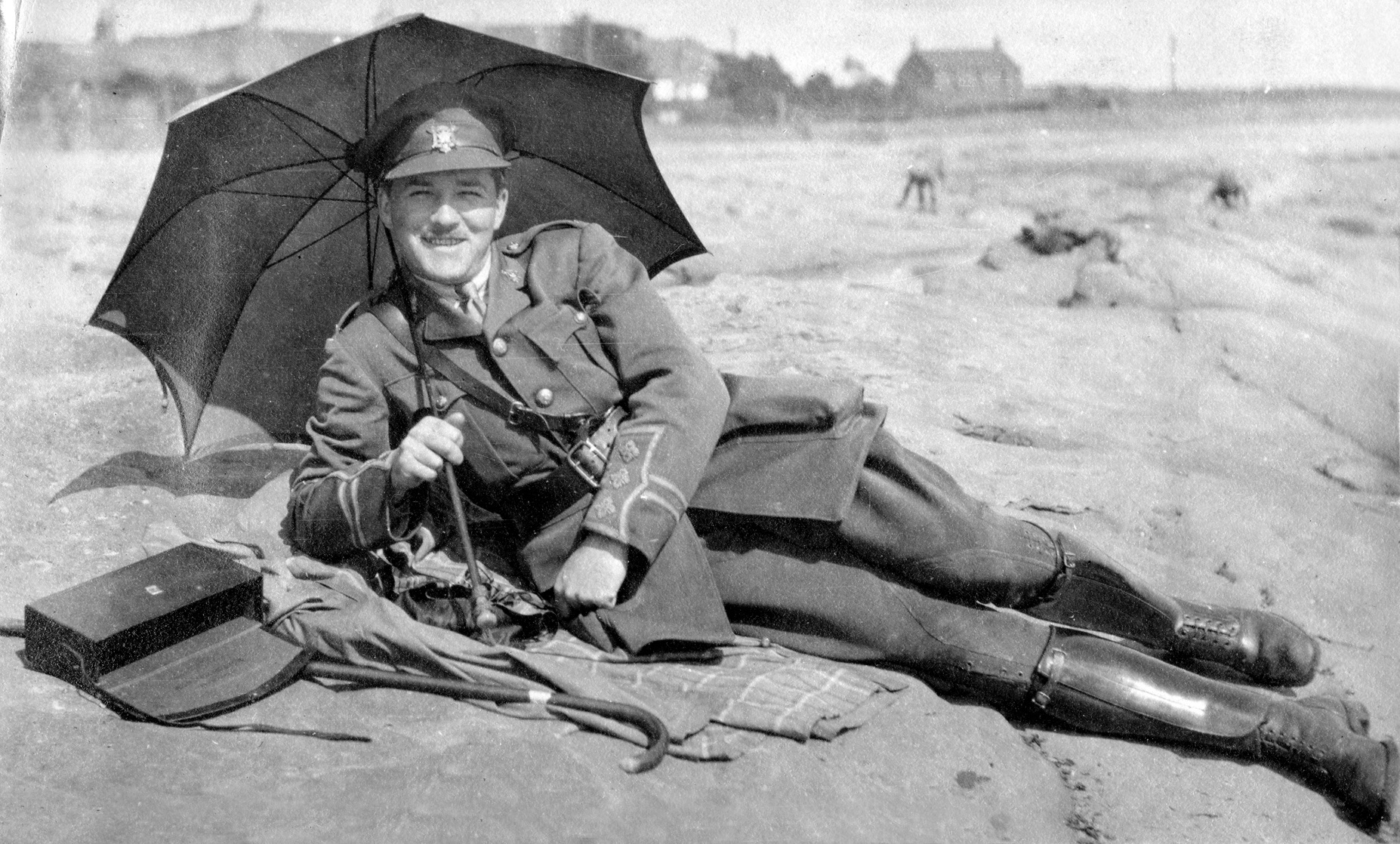
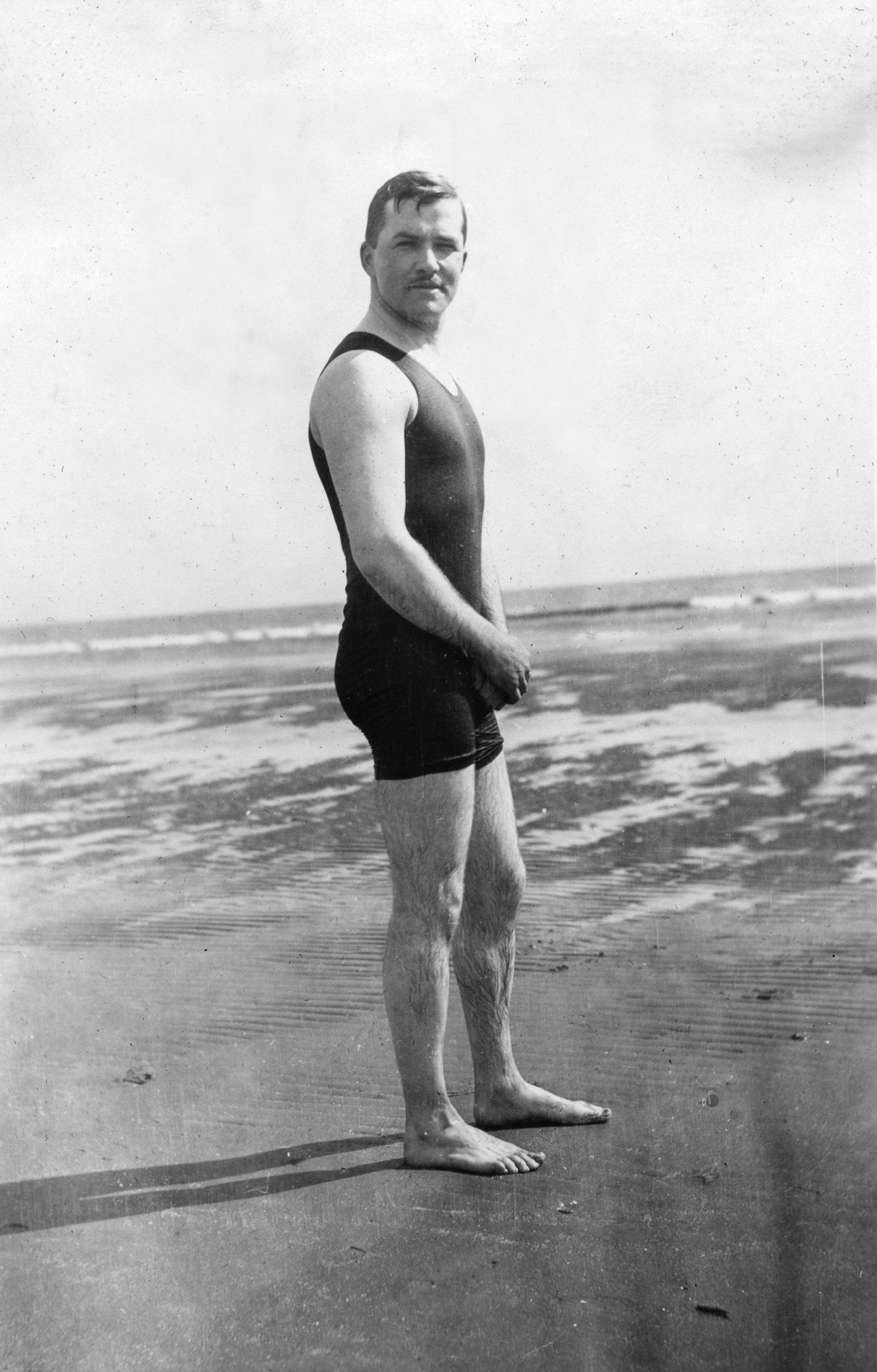
Compared to the incomprehensible carnage on the Western Front, particular for the CEF in the last hundred days, being in Scotland in 1918 was a decidedly safe place for a soldier. There were calls to the CFC to provide infantry replacements for combatant CEF divisions, particularly following the German spring offensive (March 1918). “ …. in April, of 1918, a demand was made upon the Corps for 500 men for the Infantry. Volunteers were asked for, and the number offering far exceeded the demand. Altogether the Corps sent to battalions 1,270 men.” Bird and Davies (1919, p.13). One wonders if Douglas considered such an option. Regardless, death was to find him, not by shrapnel, gas, or bullet, but by a deadly disease.
Around November 2nd 1918, Douglas developed a persistent high fever. With his condition not improving, on the afternoon of November 8th he was admitted to the Second Scottish General Hospital in the district of Craigleath, in the north part of Edinburgh.
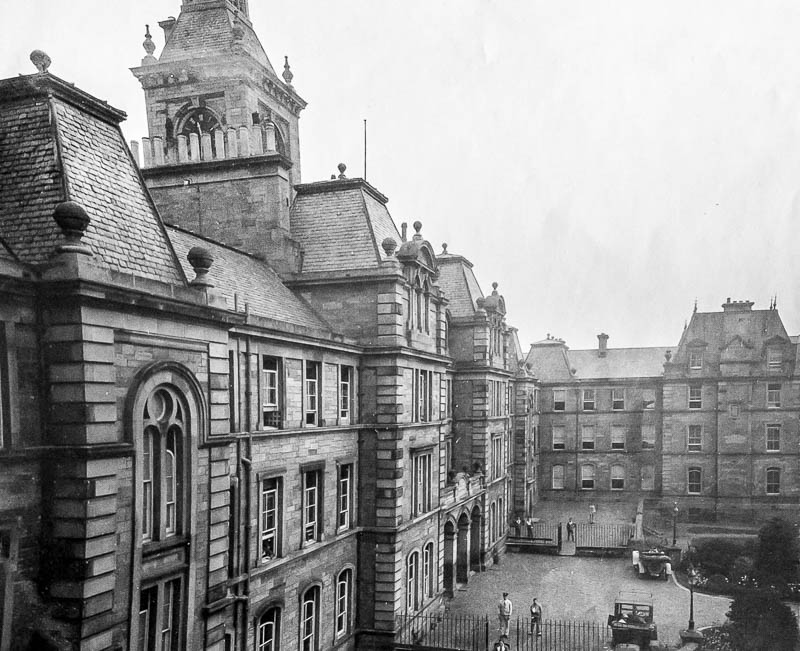
He had high fever but mostly complained of pains in the head and the back. His fever would not abate, despite treatments of stimulants2 and oxygen inhalation. On November 9th his temperature rose to 105.8°, his discomfort had migrated to his chest and he had developed pneumonia. By midnight he had drifted into delirium, and his condition grew steadily worse. He died at 12:30 am on November 12th, thirteen and one half hours after the guns had finally fallen silent in the Great War. Officially Douglas died of pneumonia following influenza. This specific strain of the influenza A virus became globally infamous as the Spanish Flu.
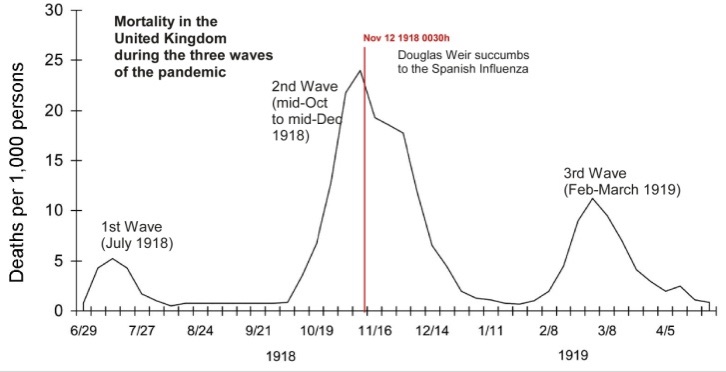
The reason the pandemic struck adults in their prime disproportionately (compared to other influenzas) has been much debated.
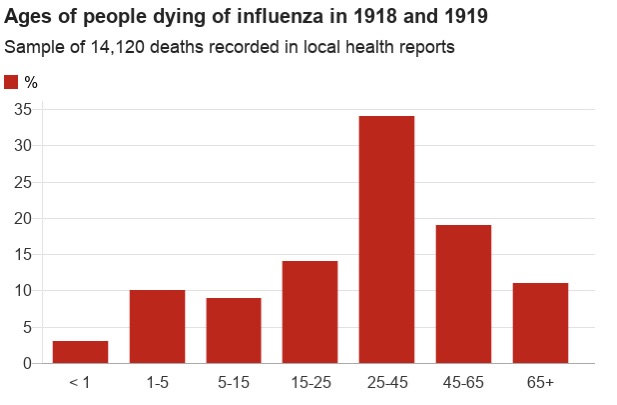
The prevalent view is that it was due, ironically, to their immune systems being too robust. In children the immune response was weak due to immaturity, and in seniors it was relatively weak due to degradation. In young healthy adults the response to this novel virus was too vigorous unleashing a cytokine storm5, which led to hyperinflammation, further leading to the shutting down of critical organs, and the patient drowning in his own fluids. In short, the body’s cure was worse than the virus itself.
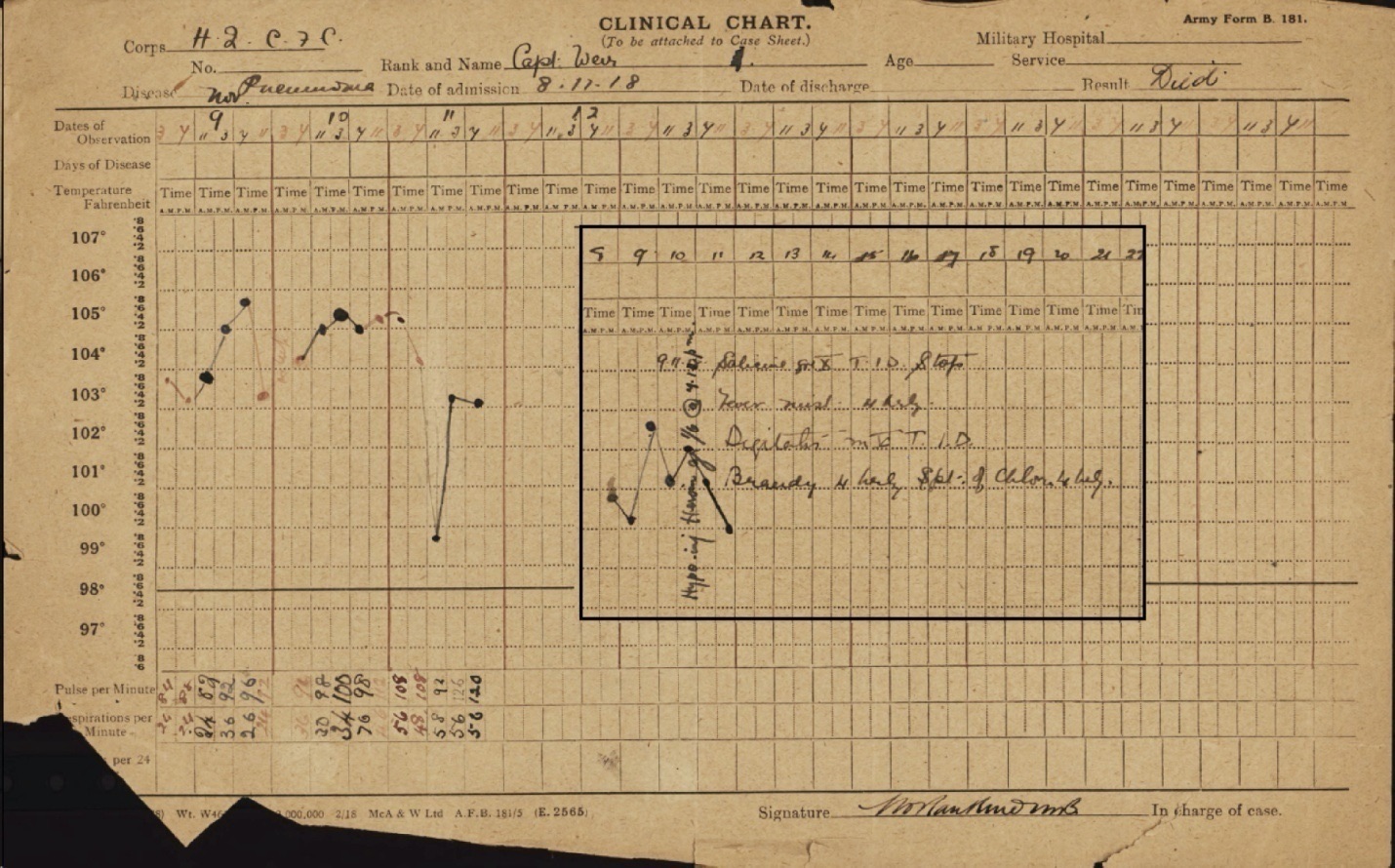
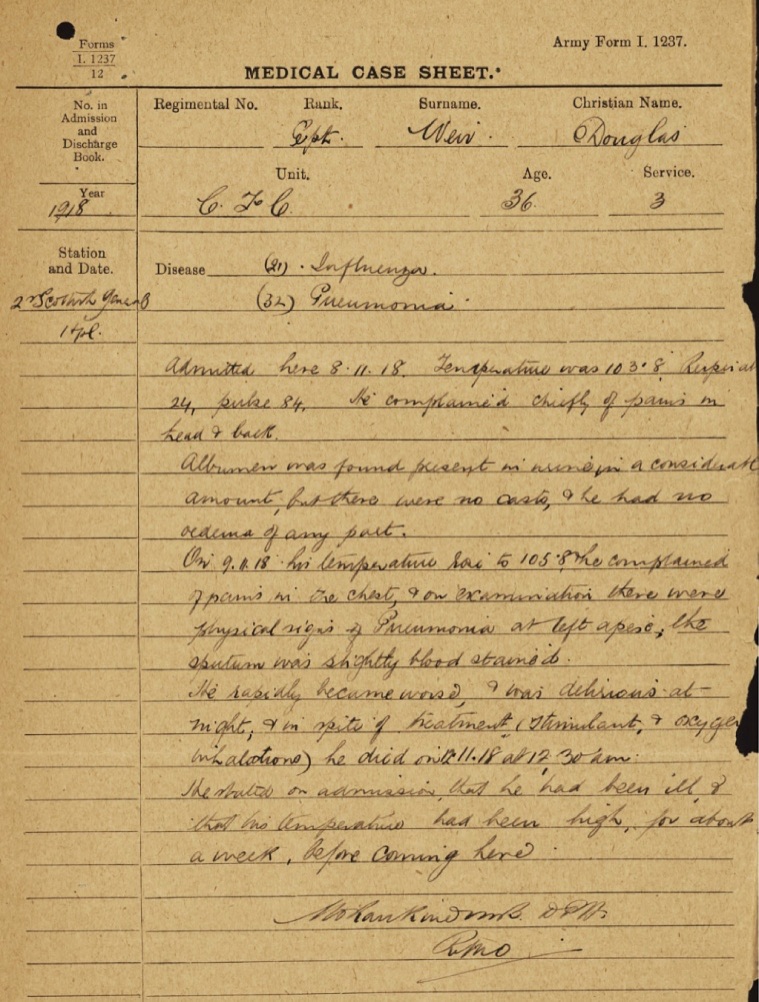
Douglas battled the disease for about 10 days, 3½ of which were spent in hospital. Many others died with greater rapidity, often within a single day.
There are no readily accessible documents that might indicate how many of the CFC personnel in Scotland came down with the disease, or died from it. Diligent research could bring these numbers to light.
Anecdotally we certainly do know that there were other deaths, indeed given the widespread nature of the pandemic in Scotland, there could be no other possibility.
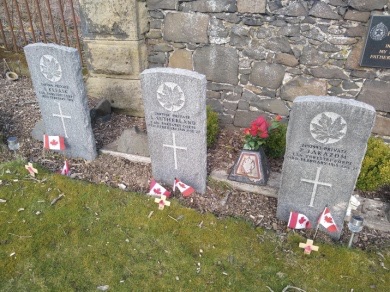
In the official history of the CFC, the pandemic is not discussed, save for the following cryptic comment in the section discussing the Corp’s medical services “…. The health of the men on the whole has been very good, making allowance for the Influenza epidemic.” (Bird and Davies; 1919, p.32)
We do know that Douglas’s wife Wilmot was at his bedside when he died. He was buried at Comely Bank cemetery, just west of the center of Edinburgh, on November 17th, tragically 2 years to the day from when he and Wilmot Gow had married.
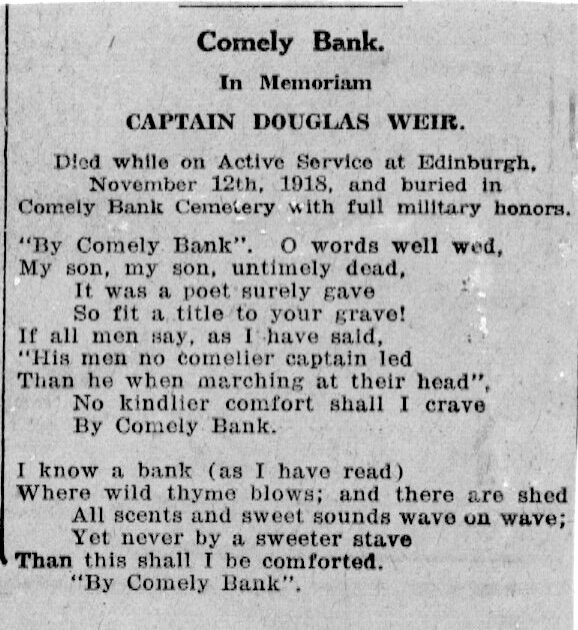
Back in Montreal the Weir household must have been devastated, the victims of an extraordinarily cruel joke. Their beloved older son had been spared the fighting, hadn’t even gotten to France (a large contingent of his CFC colleagues were stationed there).
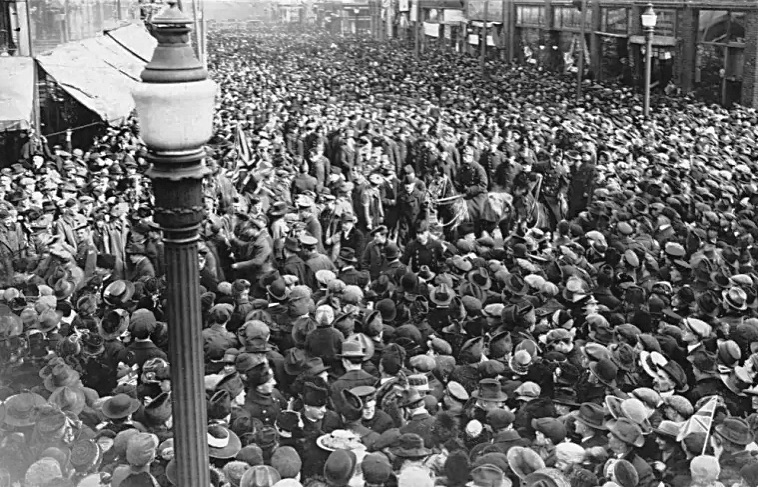
They had not been notified by telegram that he was ill or hospitalized. The rapturous news that the Armistice had been signed would have flooded the newspapers on November 11thand 12th. Jubilation reigned, the slaughter was finally over and the Allies triumphant.
In the late evening of Wednesday, November 13th came the dreaded notification from Ottawa. The stamped time of the telegram was 9:12pm EST, and evidently it was dispatched by courier to the Weirs at 9:26, I imagine arriving within the half hour on their doorstep at #96 on Westmount Boulevard.
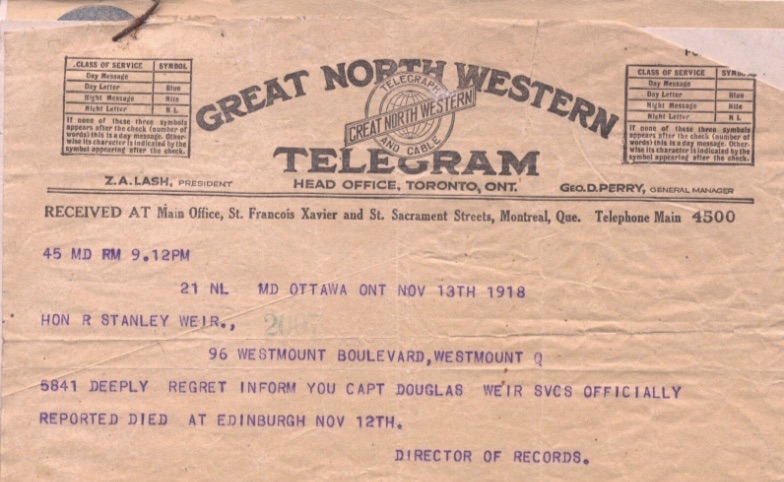
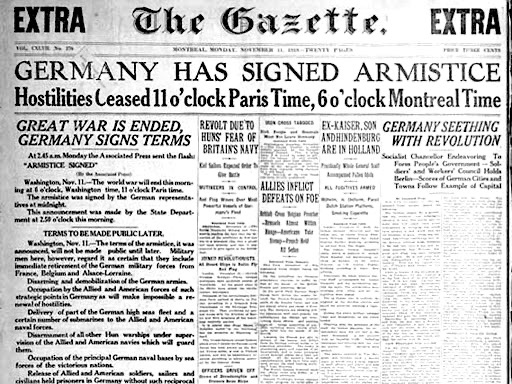
The news was brutally blunt and entirely cryptic. No doubt enquiries were made and telegrams fired off. Until answers came in the Weirs, in their grief, could only speculate. On the morning of the 14th a delegation from St. Andrew’s Church in Ahuntsic, unaware of the news, arrived at the Weirs. Robert was scheduled to give a presentation at their church that evening of two life-saving medals (the two recipients had apparently saved the life of two children at a church picnic the previous summer). The church delegation found Dr. Weir with the telegram in his hands. With delicacy one of the delegates offered their sincere condolences and said “I suppose that you will not care to be present”, to which Robert replied,“I shall be there. My boy died doing his duty, and surely the least I can do is to do mine.”
Presumably someone from the church delegation informed the press, because later that same day at least two papers made enquiries. The Weirs were still completely unaware of the circumstances of their son’s death, and Robert was moved to speculate that “the great burden of work had told on Captain Weir, and that he had been a victim of a nervous breakdown”.6
On the morning of the 15th the Weirs received a second telegram from the Director of Records (Dept of Defence), presumably responding to requests for clarification coming from Montreal. It appears that they too were still in the dark, but indicated that as soon as they heard of the particulars of Captain Weir’s death, they would let the Weir family know.
Finally on November 18th Wilmot sent a short telegram indicating the cause of death as influenza, and pleading for RSW to come across to Scotland to help her.7
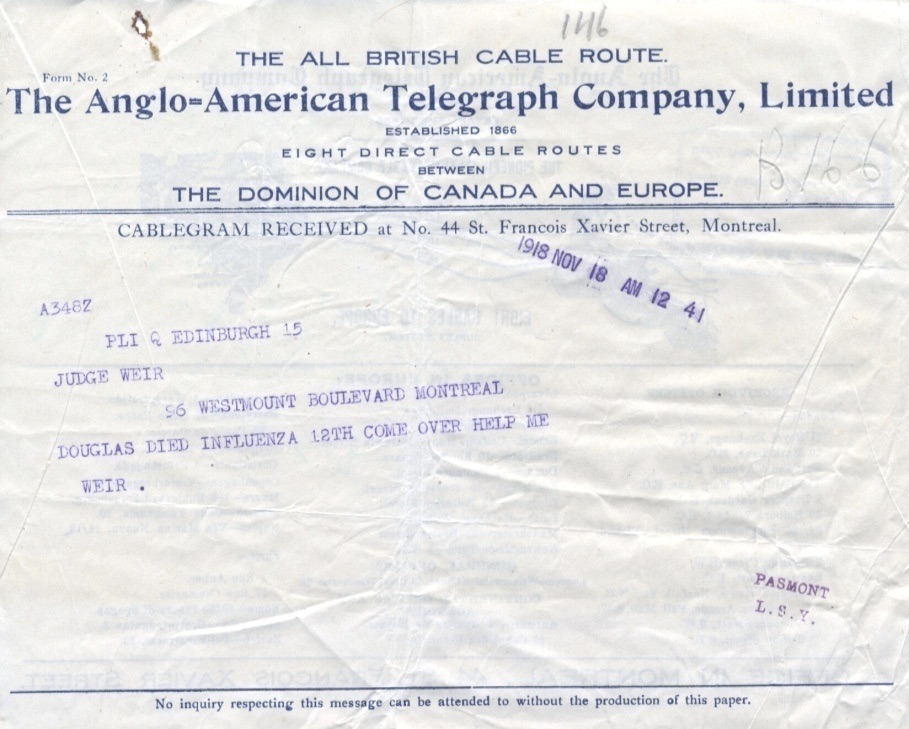
Douglas’s sister and brother-in-law were in southern England at this time, and Dr. Jim Goodall was in the Canadian Army Medical Corps. He too, had suffered through the influenza at almost the exact same time, but had come out on the other side. It would appear they became aware of Douglas’s death, perhaps through Wilmot or perhaps through Goodall’s medical colleagues, on November 19th. They didn’t know that the Weirs had been notified of his death, and so they sent a telegram to the Douglas family on Ste Famile Street in Montreal, so that someone of the near family could break the terrible news to Bert and Gertie – but of course they had known for 6 days. It is somewhat surprising that the Weirs would not have immediately cabled their daughter Beatrice in Folkstone, England on the 13th, but given the end of the war, that may simply have been impossible.8
Gertie, at least, may have taken some solace in the fact that she had gotten to England in 19169 to see her brood, and no doubt Douglas and his new wife were the highest priority visits. Robert Stanley could take no such comfort. He never fully recovered from the loss of his son. Some years later he would write the poem called Evensong, which poignantly reflected on his deep sense of loss.
Evensong RSW (published 1922 in Poems: Early and Late)
Amen. My days must soon be done
And I behold no more the sun,
I hear the bells of evensong.
What shall there be for prayer or praise
In the last hour of my days?
For what give thanks at evensong?
Oh, I have seen the lily and rose;
And how a maiden sweetly grows,
Shall I sing thus at evensong?
I have felt music’s strange delight;
And witchery of moons at night;
Shall I bless these at evensong?
And I have prized, most things above,
Laughter of children, woman’s love;
Shall I bless these at evensong?
All these, - yet vanished voice and hand
And a lone grave in distant land,
Shall fill my dreams at evensong.
References
Bartlett, Cameron John Acton 2019 Yeoman of the Woods: The Operations of the Canadian Forestry Corps During the Great War 1916-1919. M.A. Thesis University of Calgary. 139pp.
Online: Yeoman of the Woods
Bird, C.W. and Davies, J.B. 1919 The Canadian Forestry Corps: Its inception, development, and Achievements. Printed by H.M. Stationery Office, London. 49 pp. w many illustrations
Online: The Canadian Forestry Corps.
Butler, A.R. and Hogg, J.L. 2007 Exploring Scotland’s influenza pandemic of 1918–19: lest we forget
J R Coll Physicians Edinb v. 37: p.362–366
Online: Exploring Scotland's Influenza Pandemic
Taubenberger, J.K. and Morens, D.M. 2006 1918 Influenza: the Mother of all Pandemics. Emerging Infectious Diseases www.cdc.gov/eit Vol 12
Online: 1918 Influenza: the Mother of all Pandemics